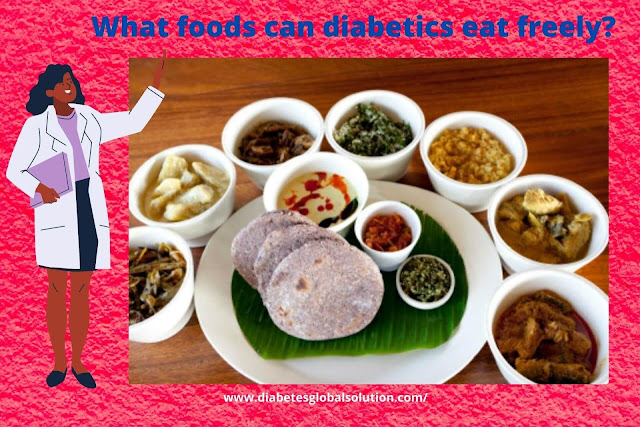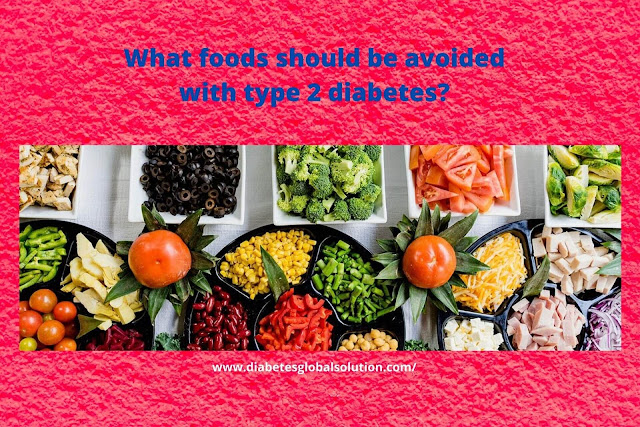There is no enchantment for Diabetes Diet Type 2, as everybody reacts diversely to specific nourishments.
Regardless of whether you're living with type 1 or type 2 diabetes, it's
critical to eat a sound, adjusted eating routine and know about the impact that
various nourishments have on your (glucose) levels.
Type 2 diabetes, in any
case, is a way of life illness and can be forestalled. This guide will
concentrate on the best eating regimen for Diabetes Diet Type 2, as a solid eating
routine, close by physical movement; can have an enormous influence in.
Type 1 diabetes is where
your safe framework assaults insulin-delivering cells, bringing about extremely
high glucose levels. In case you're an individual with diabetes, you may shuffle
a ton of concerns. Eating a sound eating routine is a major piece of the
exercise in careful control.
Unmanaged diabetes can build
your danger of creating coronary illness. Diabetic patients are additionally in
danger for visual impairment, removal and kidney disappointment. Discover
increasingly regarding why rewarding diabetes matters.
|
What foods should be avoided with type 2
diabetes?
What foods can diabetics eat freely?
What vegetables can a Type 2 diabetic eat?
What can type 2 diabetics eat for
breakfast?
|
9 Diabetes
Diet Tips to Start Today
1. Drink more water
2. Watch your carb consumption
3. Close the kitchen
4. Stop eating fast food
5. Plan a menu
6. Think green and crunchy
7. Shop smart
8. Balance your plate
9. Dining out
1. Drink
more water: Substitute water for any sugar-containing
drinks you as of now expend, including ordinary pop, sweet tea, natural product
juice, and so on. These starches go through the stomach into the circulatory
system rapidly, which can cause high blood sugars.
2. Watch
your carb consumption: Cutoff your starch admission to 30-45 grams
for each feast, or a few sugar servings. Try not to remove carbs totally;
sugars are as yet required in restricted sums since glucose is the thing that
fills the body.
Instances of starch servings
incorporate 1 cup milk, 1 cut of bread, 1 medium apple or ½ cup potatoes.
Learning segment sizes is likewise significant.
3. Close
the kitchen: Quit eating after 7 p.m., and "shut
down" your kitchen after that time.
4. Stop
eating fast food: Drive-thru eateries are advantageous yet
accompanied huge part measures loaded up with nourishments containing heaps of
starches however void calories.
5. Plana menu: Framework your feast designs at home by picking
nourishments to help control diabetes. Additionally, make a propensity
recording all that you eat to realize where your difficult
nourishments/propensities are happening and recognize changes that can be made.
6. Think
green and crunchy: Nibble on non-bland vegetables that fit the
"green and crunchy" portrayal, for example, celery, green peppers and
snap peas.
7. Shop
smart: At the point when shopping for food, prepare for the week
and continually bring a rundown - and a full stomach.
Search for entire grain,
high-fiber nourishments and breaking point your time on the walkways where
there are boxed nourishments that may not be solid. Investigate serving size
and salt and sugar content.
We as a whole should be
touchy to the additional sodium and included sugar in bundled, handled,
take-out nourishments and the Salty Six. Maintain a strategic distance from
items with a lot of sugar and search for its different names in the fixing
rundown, for example, sucrose, nectar and high fructose corn syrup.
Be careful about get one get-one
free arrangements, in such a case that they're not beneficial; you're getting
an unexpected end result.
8. Balance
your plate: Your smartest option is to begin with a
little plate. Fill half of it with vegetables, for example, cooked squash,
barbecued asparagus or a serving of mixed greens.
For the following quarter,
consider a solid carb like a little, plain yam, earthy colored rice, entire
wheat couscous or entire grain pasta.
Polish off your plate with a
lean protein, similar to a bit of fish or poultry without the skin.
9. Dining
out: When dining out, call ahead or watch online to discover
what's on the menu. Keep away from buffets, on the grounds that the incentive
to your wallet won't be felt in your waistline.
The greatest thing is parcel
control - for everybody, except particularly for individuals living with
diabetes. Think about requesting a plate of mixed greens and a hors d'oeuvre
for your feast. In the event that you get an entrée, split it or send half of
it back to be boxed up to go.
Keep a well mannered good
ways from the bread container, yet warm up to your water glass. Watch out for
the calories in different drinks - both drunkard and non-alcoholic.
Start off with a little bit
and hold up 20 minutes, Give your stomach sufficient opportunity to tell your
cerebrum that you've eaten and are getting full.
A plant-based eating regimen
high in polyunsaturated and monounsaturated fats, with restricted immersed fat
and shirking of trans-unsaturated fats, is upheld by the American Association
of Clinical Endocrinologists. Caloric limitation is suggested when weight
reduction is proper.
Type2 Diabetes and Carbohydrate Consistency
Carbohydrates are the
principle vitality source in the eating routine and incorporate carbohydrates,
vegetables, organic products, dairy items, and sugars. Most meats and fats
don't contain any sugars.
Carbohydrates legitimately
influence your glucose level, though proteins and fat have little effect. Eating
a predictable measure of carbohydrates at every supper can assist with
controlling your glucose levels, particularly on the off chance that you take
certain oral diabetes drugs or long-acting insulin.
There are various approaches
to ensure you eat a steady measure of carbohydrates for the duration of the
day, including sugar tallying and trade arranging.
Carbohydrate
Counting - The manner in which sugars are split for every feast
or tidbit will rely upon your own inclinations, the planning and dividing of
your suppers, and which diabetes meds you take. "Carb checking" is
especially significant in the event that you take insulin, as you should alter
your insulin dosages as indicated by the carbohydrate content of what you want
to eat.
Nonetheless, regardless of
whether you don't take insulin, carb tallying can assist you with keeping your
glucose levels from getting excessively low or excessively high.
The
Serving Size - Eating more than one serving will expand
the quantity of calories and sugars devoured and the portion of insulin
expected to cover the supper.
For instance, some
prepackaged bites contain at least two servings. To compute the starch
substance of the whole bundle, increase the quantity of servings by the
quantity of sugars per serving.
The
Fiber Content - when a serving of food has in excess of 5
grams of fiber, takes away the grams of fiber from the grams of sugars to
compute your insulin portion. This is on the grounds that fiber eases back the
body's ingestion of starches, so less insulin is required to oversee glucose
levels.
Exchange
Planning - With trade arranging, all nourishments are ordered as
either a starch, meat or meat substitute, or fat. In this framework, one serving
of a carbohydrate can be traded for some other sugar in light of the fact that
the two bits contain around 15 grams of carb.
You can likewise effectively
decide the sugar substance of your suppers and tidbits utilizing the trade
framework. The table shows an example every day supper plan dependent on this
framework. A dietitian can give you a progressively complete rundown of
nourishments to use for dinner arranging purposes.
Meal
Timing - Consistently eating at similar occasions each day is
significant for certain individuals, particularly the individuals who take
long-acting insulin or oral drugs that reduction glucose levels. If a supper is
skipped or deferred while on these regimens, you are in danger of growing low
blood glucose.
Intensive
Insulin Therapy - If you take various infusions of insulin
every day or utilize an insulin siphon, you can modify your pre-dinner insulin
dependent on the quantity of starches you intend to eat and your pre-feast
glucose, like patients with type 1 diabetes.
Why
is a Low-Carb Diet a good Diabetes Diet?
Keeping up stable blood
glucose levels is imperative to prevent complexities related with diabetes. As
carbs have the greatest effect on our blood glucose levels, decreasing our
intake of carbohydrate containing nourishments will diminish the measure of
glucose entering the circulatory system in any case.
This clarifies why a
low-carb diet, as opposed to a low-fat eating routine, for instance, has
consistently been associated with the avoidance and treatment of type 2
diabetes.
Current investigations have
discovered steady advantages in improved blood glucose control, weight
reduction, and supported medication reduction when people with type 2 diabetes
followed a low-carb diet.
It's likewise been
demonstrated that the low-carb diet had a high adherence rate following a year,
recommending it's an increasingly practical method of eating for the since a
long run.
A few weight control plans,
for example, the ketogenic diet (keto) wipe out carbs for the most part. By
doing this, the body is denied of its essential fuel source, glucose. The body
at that point makes new metabolic pathways and begins to go through fat for
fuel instead (ketosis).
While this sounds perfect,
it tends to be difficult to follow successfully for a long time. It's
substantially more prohibitive and one 'slip up' will remove you from ketosis
briefly.
So it's presumably more
practical to decrease your carb intake and use refined carbs (for example white
bread and white rice) with high-fiber, complex carbs (for example oats and yam)
where conceivable.
Decrease your intake of
ultra-processed foods (for example biscuits and cakes) will likewise benefit
you with evading refined carbs and diminish sweet desires.
Mediterranean-style diet in
monounsaturated fats with carbohydrates from whole grains, vegetables, natural
products, legumes, and dairy items, and an emphasis on foods higher in fiber
and lower in glycemic load.
The Mediterranean diet
routine has plant nourishments, for example, greens, tomatoes, onions, garlic,
herbs, whole grains, legumes, nuts, and olive oil as the essential source of
fat.
A crossover trial of
grown-ups with T2DM showed a measurably huge A1C decrease (from 7.1% to 6.8%)
following 12 weeks on the Mediterranean eating diet.
Low-Carbohydrate
Diet
Low-carbohydrate diets from
food have diminished in prominence because of worries about their consequences
for renal function, possible absence of supplements, and theory that their
macronutrient structure may have impacts on weight beyond those clarified by
caloric shortage.
A meta-investigation of 13
investigations of adults with T2DM following a low-carbohydrate diet (≤ 45% of
calories from starches) exhibited gainful impacts on fasting glucose, A1C, and
triglyceride levels.
Nine of the examinations
assessed glycemic control and discovered A1C decrease with lower sugar
carbohydrate diet; the best decreases in A1C and triglycerides were connected
with the most minimal carbohydrate intakes. No critical impacts were seen for
total, HDL, or LDL cholesterol.
A fourteen day investigation
of 10 grown-ups with T2DM found that only one week on a low-carbohydrate diet
diminished the normal 24-h plasma glucose from 135 mg/dL to 113 mg/dL. Over the
fourteen day study period, triglycerides diminished by 35%, cholesterol by 10%,
and A1C by 0.5%.
Patients were permitted to
take as much protein and fat as wanted. Food sources included beef and ground
turkey patties, chicken bosoms, turkey, ham, steamed vegetables, butter, diet
gelatin, and a restricted measure of cheese.
Mean calorie intake
diminished from 3,111 to 2,164 calories/d. carbohydrate consumption diminished
from 300 to 20 g/d. Weight reduction was altogether clarified by the mean
energy deficit.6 Patients encountered no distinction in appetite, satisfaction,
or vitality level with a low-carb diet contrasted with their normal eating
routine.
A writing audit of six
examinations analyzed the impacts of low-carb diets (between 20-95 g/d) on body
weight and A1C in patients with T2DM. Three of the investigations confined
carbohydrate consumption to under 50 g/d. Every single reported decrease in
body weight and A1C.
In two examinations, most of
the weight reduction was clarified by an reduction in fat, not loss of water
weight. No harmful impacts on cardiovascular disease hazard, renal capacity, or
nourishing consumption were seen.
The analysts analyzed that
low-carb consumes less carb diet are protected and effective over the present
moment for individuals with T2DM.
Paleolithic
Diet
The Paleolithic eating
routine (additionally called as the cavemen diet, Stone Age diet, and
hunter-gather eating diet) includes eating foods accepted to have been accessible
to people before agriculture-this period started about 2.5 million years back
and finished around 100,000 years prior.
Food sources incorporate
wild animal meat (lean meat and fish) and uncultivated plant nourishments
(vegetables, fruits, roots, eggs, and nuts). It excludes grains, vegetables,
dairy items, salt, refined sugar, and prepared oils.
7 Days Diet Meal Plan for Diabetes Type
|
Days
|
1
|
2
|
3
|
4
|
5
|
6
|
7
|
|
Breakfast
|
Cream
Cheese-Stuffed French Toast
|
Apple Pie Oatmeal with Greek Yogurt
|
Super food Smoothie/ Natural untoasted
muesli with mixed berries (fresh or frozen) and low-fat natural / Greek
yoghurt
|
Veggie and Goat Cheese Scramble/ Natural
untoasted muesli with mixed berries (fresh or frozen) and low-fat
natural/Greek yoghurt
|
Granola with Nuts, Seeds, and Dried Fruit /
Raspberry and yogurt Bircher muesli
|
Banana-Carrot and Pecan Muffins / Breakfast
pocket with an
unsweetened, reduced-fat milk drink, e.g. a
milk-based coffee
|
Tomato and Basil Frittata / Natural
untoasted muesli with mixed berries (fresh or frozen) and low-fat
natural/Greek yoghurt
|
|
Morning Tea
|
An unsweetened, reduced-fat milk drink,
E.g. a milk-based coffee and 1 serve of fruit
|
Wholegrain crackers with reduced-fat cheese
|
An unsweetened, reduced-fat milk drink, E.g.
a milk-based coffee
|
An unsweetened, reduced-fat milk drink / 1
glass of buttermilk 1 apple
|
An unsweetened, reduced-fat milk drink,
e.g. a milk-based coffee and a small handful of unsalted nuts.
|
1 serve of fruit
|
An unsweetened, reduced-fat milk drink / 1
glass of buttermilk 1 apple
|
|
Lunch
|
Salmon Salad with White Beans/ Wholegrain crisp
breads with avocado, tuna, tomato and reduced-fat cheese.
|
Turkey-Cranberry Wraps / Left over jeweled
couscous salad + a small pot of reduced-fat yoghurt
|
Spinach and Tomato Pasta / Vietnamese
turkey salad wrap and apple slices
|
Curried Chicken Salad Stuffed Pitas / Vietnamese
turkey salad wrap and 1 serve of fresh fruit
|
Quinoa Tabbouleh Salad / Left over pepper
beef stir-fry with Brussel sprouts
|
Lemony Hummus / Chicken and pumpkin open
sandwich and 1 small pot of reduced-fat yoghurt.
|
Butternut Squash and Carrot Soup / Vietnamese
turkey salad wrap and 1 serve of fresh fruit
|
|
Afternoon Tea
|
Cut up vegetable sticks with healthy hummus
and a handful of unsalted nuts
|
Corn thins with natural peanut butter and ½
of a banana
|
Cut up vegetable sticks with healthy hummus
|
Corn thins with cottage cheese and tomato /
1 cup Lemon green tea without sugar/honey 0.25 cup Roasted Chana
|
Corn thins with peanut butter and ½ sliced
banana
|
Cut up vegetable sticks with healthy hummus
|
Corn thins with cottage cheese and tomato /
1 cup Lemon green tea without sugar/honey 0.25 cup Roasted Chana
|
|
Dinner
|
Cuban-Marinated Sirloin Kabobs with Grilled
Asparagus / Jeweled couscous salad, Low-fat natural/Greek yoghurt and berries
|
Cilantro-Lime Tilapia with Spinach and
Tomatoes / Grilled or BBQ salmon fillet with strawberry and spinach salad,
grilled corn and asparagus, Mixed berry fool
|
Grilled Turkey Burgers / Pepper beef
stir-fry with Brussels sprouts, Walnut and raisin drops.
|
Jamaican Pork Tenderloin with Lemony Green
Beans / Grilled lamb cutlets with pumpkin risoni salad and additional steamed
greens, Walnut and raisin drops
|
Beef and Rice Stuffed Peppers/ Chicken, pea
and basil linguine served with a side green salad, Reduced-fat natural/Greek
yoghurt with a small serve of seasonal fruit salad and a sprinkling of
cinnamon
|
Chicken Tortilla Soup / Vegetable burgers, Poached
pears with espresso sauce plus low-fat natural/Greek yoghurt
|
Grilled Shrimp Skewers / Grilled lamb
cutlets with pumpkin risoni salad and additional steamed greens, Walnut and
raisin drops
|
Conclusion
There are three sections to type 2 diabetes the board: dietary changes, a movement plan and prescription. Turner suggests learning everything you can about diabetes to get it controlled rapidly, before more insulin opposition is made from high glucose levels.
Our bodies react better to way of life changes right off the bat in the ailment procedure, as opposed to permitting uncontrolled diabetes to continue for a couple of years before quitting any and all funny business about dealing with the condition.
Way of life changes to a great extent incorporate a solid food plan, yet turning out to be truly dynamic encourages our bodies to decrease insulin opposition too.
Figuring out how to diminish the measure of starches you eat implies your glucose will be lower, as the admission of carbs is straightforwardly attached to your glucose esteem.
It is highly unlikely to accept enough drugs to eat as much food as you need. In the event that we devour an excessive number of starches, at that point we end up likewise putting away the additional glucose as fat, which builds our insulin opposition. Shockingly, it makes an endless loop of helpless diabetes control.
|
Tag
Type 2 diabetes diet sheet
Type 2 diabetes foods to avoid
Type 2 diabetes food chart
Type 2 diabetes diet plan pdf
Type 2 diabetes diet plan lose weight
Type 2 diabetes recipes
Type 2 diabetes diet plan printable
|





Post a Comment